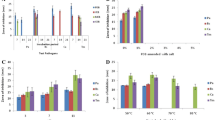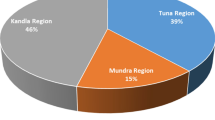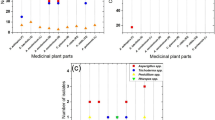Abstract
An endophytic fungus displaying considerable antimicrobial activity was isolated from stem tissue of an invasive plant species, Ipomoea carnea. The fungus was identified as Quambalaria sp. and confirmed by ITS rDNA sequence analysis. A BLAST search result of the sequence indicated 97 % homology with Quambalaria cyanescens. Crude metabolites of the fungus showed considerable antimicrobial activity against a panel of clinically significant microorganisms. The metabolites showed highest in vitro activity against Shigella dysenteriae followed by Escherichia coli and Candida albicans. Optimum metabolites production required neutral pH and a 15-day incubation period. Bark extracts amended with fungal media demonstrated higher antimicrobial activity. Optimum metabolites activity was recorded in Czapek Dox broth amended with leaf extracts (CDB + LE) of the host plant. The metabolites showed UV λ-max in ethyl acetate at 284.6 nm with an absorbance value of 1.093. Phylogenetic tree generated by the Maximum Parsimony method showed clustering of our isolate with Q. cyanescens with supported bootstrap of 65 %. Species of Quambalaria are pathogens to Eucalyptus and occurrence of this fungus as endophytes support it to be a latent pathogen. Sequence base analysis and RNA secondary structure study also confirmed such a relationship. Secondary structural features like two hinges and a 5’ dangling end were found to be unique to our isolate. These structural features can also be used as potential barcodes for this fungus. The findings indicate that invasive plant species can be a reliable source of novel endophytes with rich antimicrobial metabolites. The study also validates the assumption that endophytes can become parasites and share a close affinity.







Similar content being viewed by others
References
Amin RM, Strobel GA, Vishnevetsky M, Ren Y, Geary B (2010) Biologically active endophytic Quambalaria sp. from Leptospersmum junipae in Australia. Mycology 1(1):67–74
Beer JW, Begerow D, Bauer R, Pegg GS, Crous PW, Wingfield MJ (2006) Phylogeny of the Quambalariaceae fam. nov., including important Eucalyptus pathogens in South Africa and Australia. Stud Mycol 55:289–298
Brown KB, Hyde KD, Guest DL (1998) Preliminary studies on endophytic fungal communities of Musa acuminata species complex in Hong Kong and Australia. Fungal Divers 1:27–51
Carroll G (1988) Fungal endophytes in stems and leaves from latent pathogen to mutualistic symbiont. Ecology 69:2–9
Coleman AW (2007) Pan-eukaryote ITS2 homologies revealed by RNA secondary structure. Nucleic Acids Res 35:3322–3329
Gogoi DK, Boruah HD, Saikia R, Bora TC (2008) Optimization of process parameters for improved production of bioactive metabolite by a novel endophytic fungus Fusarium sp. DF2 isolated from Taxus wallichiana of North East India. World J Microbiol Biotechnol 24:79–87
Guo LD, Hyde KD, Liew ECY (2001) Detection and taxonomic placement of endophytic fungi within frond tissues of Livistona chinensis based on rDNA sequences. Mol Phylogenet Evol 20:1–13
Hsieh C, Tsai MJ, Hsu TH, Chang DM, Lo CT (2005) Medium optimization for polysaccharide production of Cordyceps sinensis. Appl Biochem Biotechnol 120:145–157
Hyde KD, Soytong K (2008) The fungal endophyte dilemma. Fungal Divers 33:163–173
Keller A, Schleicher T, Forster F, Ruderisch B, Dandekar T, Muller T, Wolf M (2008) ITS2 data corroborate a monophyletic chlorophycean DO-group (Sphaeropleales). BMC Evol Biol 8:218
Maria GL, Sridhar KR, Raviraja NS (2005) Antimicrobial and enzyme activity of mangrove endophytic fungi of southwest coast of India. J Agric Technol 1:67–80
Miao M, Warrenb A, Songa W, Wangc S, Shanga H, Chena Z (2008) Analysis of the Internal Transcribed Spacer 2 (ITS2) region of Scuticociliates and Related Taxa (Ciliophora, Oligohymenophorea) to infer their evolution and phylogeny. Protist 159:519–533
Ohmichi T, Nakano S, Miyoshi D, Sugimoto N (2002) Long RNA dangling end has large energetic contribution to duplex stability. J Am Chem Soc 124:35
Park JP, Kim SW, Hwang HJ, Yun JW (2001) Optimization of submerged culture conditions for the mycelial growth and exo-biopolymer production by Cordyceps militaris. Lett Appl Microbiol 33:76–81
Rubini MR, Rute TSR, Pomella AW, Cristina SM, Arajo LW, Santos DRD, Azevedo JL (2005) Diversity of endophytic fungal community of cocao (Thebroma cacao L.) and biological control of Crinipellis perniciosa, causal agent of Witches’ Broom disease. Int J Biol Sci 1:24–33
Schultz J, Wolf M (2009) ITS2 sequence-structure analysis in phylogenetics: A how to manual for molecular systematics. Mol Phylogenet Evol 52:520–523
Schulz B, Boyle C (2005) The endophytic continuum. Mycol Res 109:661–686
Selig C, Wolf M, Müller T, Dandekar T, Schultz J (2008) The ITS2 Database II: homology modelling RNA structure for molecular systematic. Nucleic Acids Res 36(Database issue):D377–D380
Shipunov A, Newcombe G, Raghavendra AKH, Anderson CL (2008) Hidden diversity of endophytic fungi in an invasive plant. Am J Bot 95:1096–1108
Sieber T (2007) Endophytic fungi in forest trees: are they mutualists? Fungal Biol Rev 21:75–89
Simpson JA (2000) Quambalaria, A New Genus of Eucalypt pathogens. Australas Mycol 19(2):57–62
Stodulkova E, Sulc M, Cisarova I, Novak P, Kolarik M, Flieger M (2008) Production of (+) globulol needle crystals on the surface mycelium of Quambalaria cyanescens. Folia Microbiol 53(1):15–22
Strobel GA (2001) Microbial gifts from the rain forest. Can J Phytopathol 24:14–20
Strobel GA, Daisy B (2003) Bioprospecting for microbial endophytes and their natural products. Microbiol Mol Biol Rev 67:491–502
Strobel GA, Knighton B, Kluck K, Ren Y, Livinghouse T, Griffin M, Spakowicz D, Sears J (2008) The production of myco-diesel hydrocarbons and their derivatives by the endophytic fungus Gliocladium roseum (NRRL 50072). Microbiology 154:3319–3328
Tamura K, Dudley J, Nei M, Kumar S (2007) MEGA4: Molecular Evolutionary Genetics Analysis (MEGA) software version 4.0. Mol Biol Evol 24:1596–1599
Tejesvi MV, Tamhankar SA, Kini KR, Rao VS, Prakash HS (2009) Phylogenetic analysis of endophytic Pestalotiopsis species from ethnopharmaceutically important medicinal trees. Fungal Divers 38:167–183
Tong WY, Darah I, Latiffah Z (2011) Antimicrobial activities of endophytic fungal isolates from medicinal herb Orthosiphon stamineus Benth. J Med Plant Res 5(5):831–836
Wang Y, Guo LD, Hyde KD (2005) Taxonomic placement of sterile morphotypes of endophytic fungi from Pinus tabulaeformis (Pinaceae) in northeast China based on rDNA sequences. Fungal Divers 20:235–260
Zuker M (2003) Mfold web server for nucleic acid folding and hybridizationprediction. Nucleic Acids Res 31(13):3406–3415
Acknowledgements
The authors are grateful to the coordinator, Bioinformatics Infrastructure facility (BIF), and the Head, Department of Botany, North Orissa University, India, for providing necessary facilities to carry out the work. Financial support in the form of studentship by DBT-BIF, Govt. of India, to the first author is greatly acknowledged.
Author information
Authors and Affiliations
Corresponding author
Electronic supplementary material
Below is the link to the electronic supplementary material.
ESM Fig. 1
Colonial morphology (a) and spores (b) of Quambalaria sp. (DOC 87 kb)
ESM Fig. 2
Antagonistic activity of the metabolites of Quambalaria sp. under different cultural conditions against some bacteria and fungi. (DOC 1112 kb)
Rights and permissions
About this article
Cite this article
Padhi, S., Tayung, K. Antimicrobial activity and molecular characterization of an endophytic fungus, Quambalaria sp. isolated from Ipomoea carnea . Ann Microbiol 63, 793–800 (2013). https://doi.org/10.1007/s13213-012-0534-4
Received:
Accepted:
Published:
Issue Date:
DOI: https://doi.org/10.1007/s13213-012-0534-4




